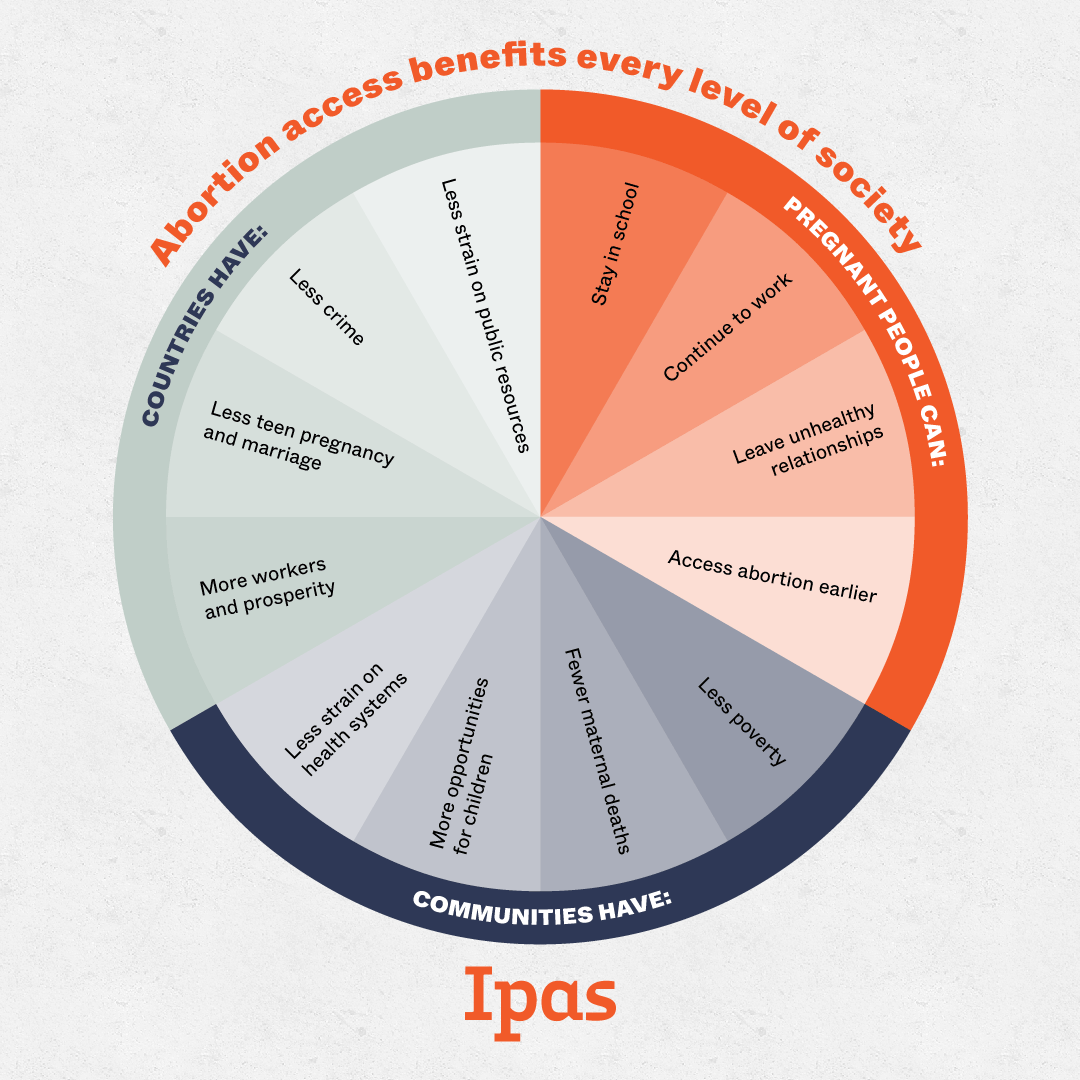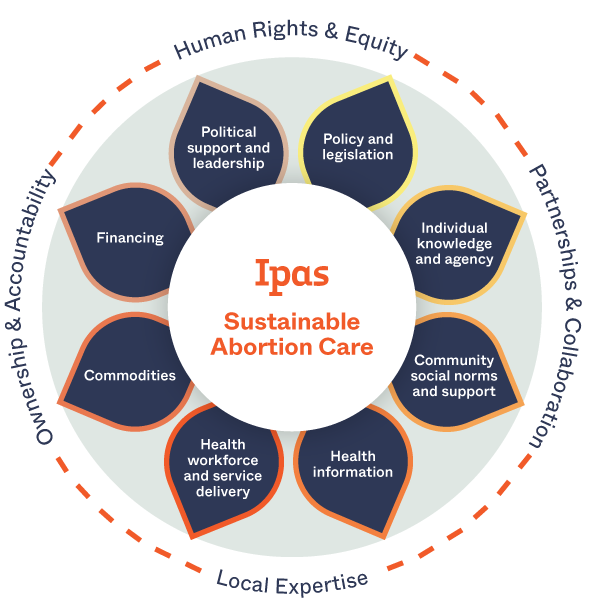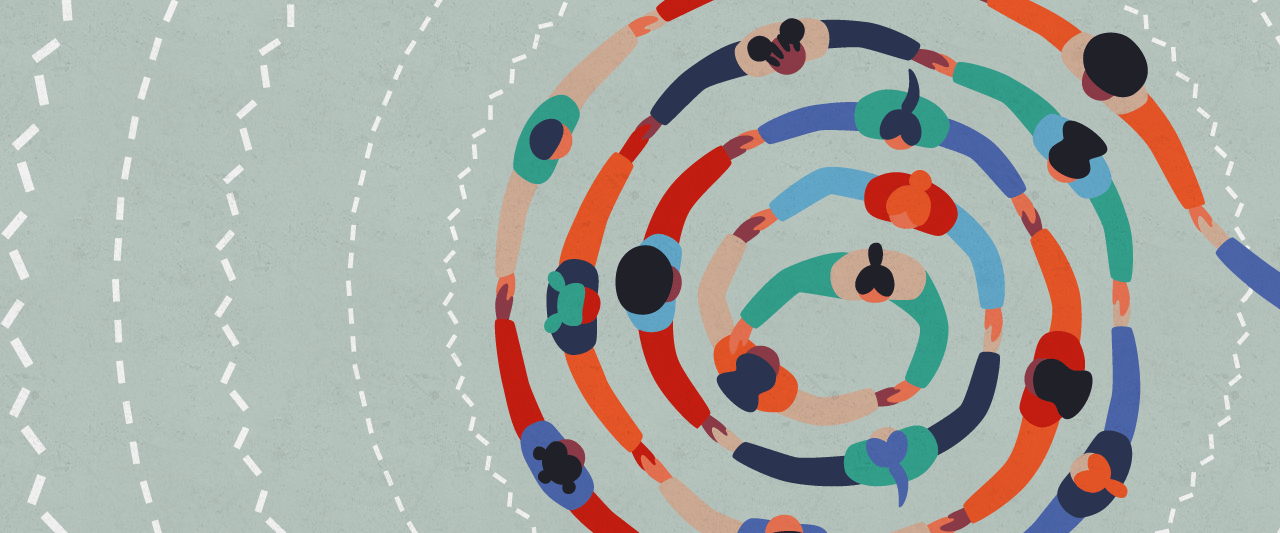When people can safely get an abortion, it not only improves their own quality of life, but that of their families, communities and even countries. In a recent collaboration with partners at Rutgers University and London School of Economics, Ipas conducted a global review of research on the impact of abortion access at the individual, community, and country levels. Findings show that when abortion access is achieved by making it legal, available and affordable, the trickle-down benefits are vast and far-reaching.
This comprehensive assessment of global research specifically looked at the impact of abortion access and abortion policies on economic outcomes.
“This expansive body of evidence shows the wide variety of factors that compound each other to impact costs, access and stigma for people who need abortion care,” says Brittany Moore, scientific and technical division advisor for Ipas. “We see this work as a valuable resource for advocates and hope it will inspire further research—especially for places where no studies have been done on the impacts of abortion access. While the results of this review were significant, it is clear there is still so much space to do more.”
Three factors for positive impact
Research clearly shows that legal, affordable and available abortion care adds up to widespread benefits.
When abortion is legal, people experience fewer delays in receiving reproductive health care, and are less likely to choose unsafe abortion methods that increase the risk of death and injury. When people don’t require treatment for complications of unsafe abortion, health systems are less strained under the immense need for staff and resources.
Even when abortion is legal, keeping care affordable is essential for fair access. In addition to service fees, many factors can add to overall abortion costs: childcare, overnight accommodation, travel costs, time off work and follow-up visits. People sometimes struggle to gather funds, which can cause significant delays or even prove impossible. The more affordable abortion care is, the less people delay in getting the care they need.
Enough facilities, providers, and options for telemedicine and abortion with pills are all needed to ensure abortion is available. While people with wealth can often get an abortion regardless of local policies, people who are low-income, young, and/or living in rural places are less able to manage increased cost and distance. When abortion is available, fewer people must travel great distances to reach an abortion provider.
Abortion access = Benefits at every level of society
Research from around the world shows that across a variety of cultures and political contexts, legal, available and affordable abortion care benefits individuals as well as their communities and countries.
When abortion is legal, available and affordable, pregnant people can:
Stay in school
Substantial global evidence shows that, particularly among adolescents and younger women, the ability to obtain or continue an education is an important benefit of abortion access. This is true in diverse settings, including the U.S., Ghana, Brazil, New Zealand, India, and Guadaloupe. Multiple studies link legal abortion to increased high school graduation and college attendance.
Continue to work
Many studies show when people are forced to choose unsafe abortion, they and their family suffer financial hardship through health-care debt and job loss—and loss of lifetime earnings in cases where a woman dies from unsafe abortion. Legal abortion is connected in some studies to a decline in childbearing, which is in turn linked to a rise in women’s economic progress.
Avoid unhealthy relationships
The ability to leave unhealthy relationships proves to be a critical benefit for those able to choose abortion. Findings show abortion access can help a woman avoid violence in a controlling relationship in the United Kingdom, avoid becoming a second wife in Ghana, and end an unhealthy relationship in Colombia and Indonesia.
Access abortion earlier
Finding money for transportation is a major cause of delayed abortions in Zambia, Northern Ireland and Australia. In Kenya, a requirement that patients pay prior to each procedure restricts access to prompt care, while in the U.S., health insurance issues cause delays. In Colombia, having to gain health insurance coverage through an external agency caused women to have their abortions later than they had desired.
When abortion is legal, available and affordable, communities have:
Less poverty
Many studies show that when people can end an unwanted pregnancy, they have more time to establish stable relationships, complete education, and secure financial footing. For example, a U.S. study showed that children of mothers who had previous abortions are less likely to be in single-parent households and are less likely to live in poverty or receive welfare than those from similar socioeconomic backgrounds who did not.
More opportunities for children
While historical evidence from Romania’s abortion ban showed a significant decline in educational and labor market achievements of those born during the ban, studies from both Sub-Saharan Africa and Taiwan linked abortion law liberalization to greater parental investment in girls’ schooling. In the United States, children born after the Supreme Court’s 1973 Roe v. Wade ruling faced lower infant mortality.
Fewer maternal deaths
The risk of dying from childbirth is 50 to 130 times greater than dying from an abortion. One comprehensive analysis of maternal mortality around the world found that unsafe abortion accounts for a higher percentage (10%) of maternal mortality in Latin America and the Caribbean than in any other region, followed closely by Sub-Saharan Africa; both these regions have highly restrictive abortion laws. In contrast, unsafe abortion causes fewer than 1% of maternal deaths in East Asia, a region with less restrictive abortion laws.
Less strain on health systems
Studies from Ghana and Nigeria show how access to safe abortion for 60% of women that would otherwise get an unsafe abortion translates to many years of life saved: almost 11,000 years of life saved per 100,000 procedures in Nigeria and 17,500 years of life saved per 100,000 procedures in Ghana. In Burkina Faso, safe abortion services would only cost 12% of what health facilities spent treating complications of unsafe abortion.
When abortion is legal, available and affordable, countries have:
More workers and prosperity
In the United States, legal abortion increases the amount of women in the workforce and overall gross domestic product. In Oslo, Norway, greater abortion access led to higher educational attainment, and abortion access for teenagers led to more women joining the workforce at younger ages.
Less teen pregnancy and marriage
Starting in 1969, teenagers in Oslo had access to abortion services that were generally denied to teenagers in other parts of Norway. This abortion access translated into lower rates of teen pregnancy, higher age before having children, and a small increase in completed family size. In Eastern Europe, increasing abortion access led to a large decrease of teenagers having children and an increase in marriage rates for non-teenage women. In the United States, states that funded abortion services had lower birth rates among teenagers.
Less crime
A widely cited study from the United States found that crime rates across the country appear to have dropped as a result of legalized abortion causing fewer unwanted births in low-income households. Abortion liberalization reduced the number of unwanted births, with a later reduction in crime years later when those babies would have been adults.
Less strain on public resources
Estimates from 2006 show that treating complications of unsafe abortion cost health systems in developing countries $553 million per year. In addition, households experienced $922 million in loss of income when women suffered permanent injury or disability due to unsafe abortion, leading to need for public aid. One Tanzanian study showed the cost per day of treating complications from illegal and unsafe abortion was more than seven times the ministry of health’s annual per capita budget.

Abortion access = A crucial benefit for mothers
Research from around the world shows that the ability to decide when and whether to have another child helps mothers take better care of themselves and the children they already have.
One study from the United States, where 61% of women who have abortions are already mothers and more than half of whom have two or more children, provided the case example of Angel [a pseudonym]:
SDI Productions/ iStock
All articles in this research collection are available online through open access:
- Economics of abortion: a scoping review protocol
- History and scientific background on the economics of abortion
- The microeconomics of abortion: A scoping review and analysis of the economic consequences for abortion care-seekers
- The mesoeconomics of abortion: A scoping review and analysis of the economic effects of abortion on health systems
- The macroeconomics of abortion: A scoping review and analysis of the costs and outcomes
- The economics of abortion and its links with stigma: A secondary analysis from a scoping review on the economics of abortion


